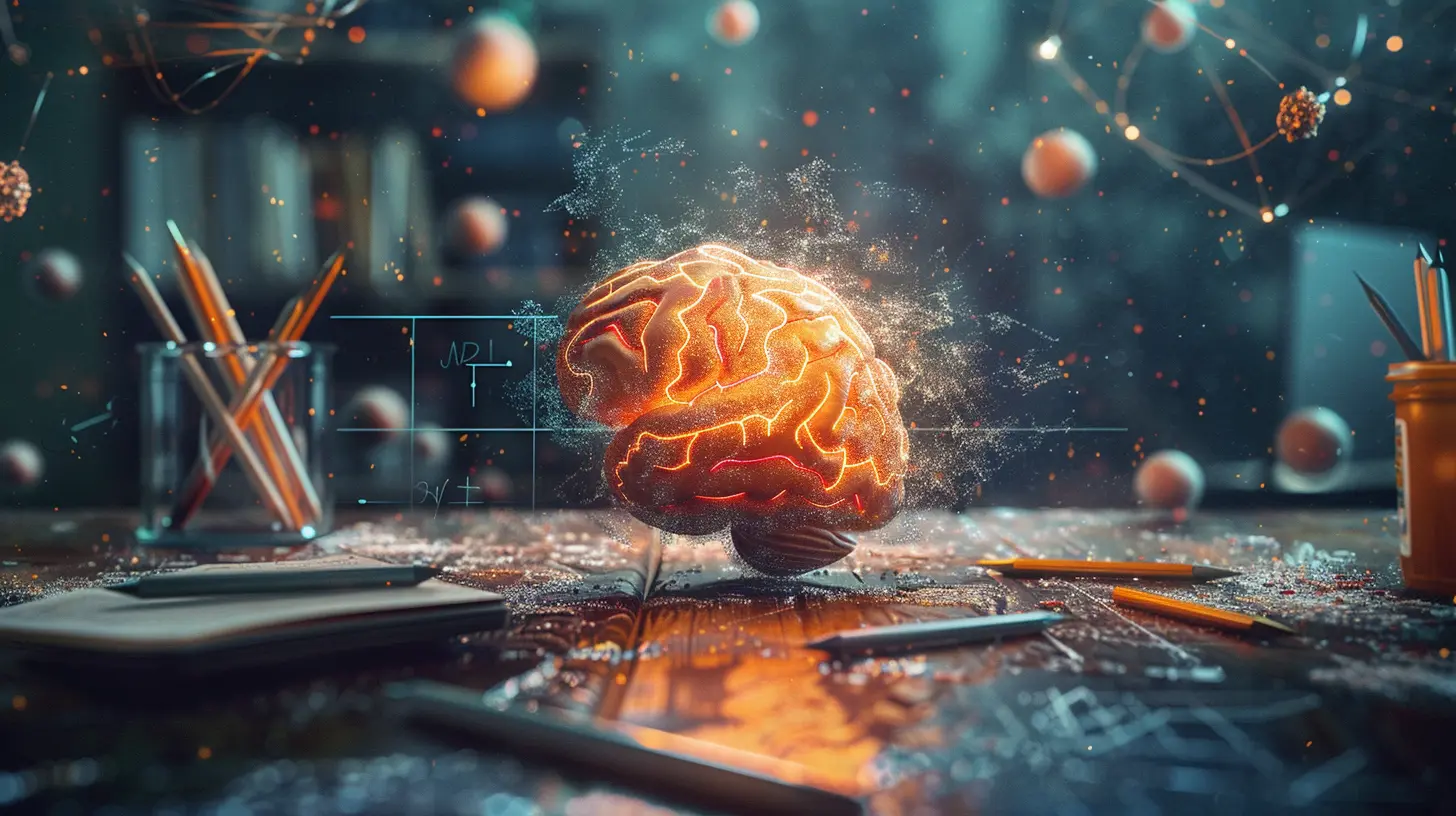How to Learn Faster: Science-Based Techniques for Skill Acquisition
5 December 2024
We’ve all been there—trying to learn something new, only to hit a wall. Maybe it’s a new language, a musical instrument, or even a professional skill. But what if I told you there are science-backed ways to speed up your learning process? That’s right! You don’t need superhuman abilities to learn faster. All it takes is understanding how your brain works and applying the right techniques.
In this article, we’ll dive into science-based methods for faster skill acquisition. Whether you're a student, a professional, or just someone who loves learning, these tips will boost your learning curve and make you more efficient. So, buckle up, because you’re about to become a learning machine!

The Science of Learning: How Our Brains Absorb Information
Before we dive into the techniques, let’s start with the basics: how does learning happen in the brain?When you learn something new, your brain creates neural connections. Think of these connections like pathways in the forest—at first, the trail is barely visible. But the more you walk that path, the clearer it becomes. This is called neuroplasticity, which refers to the brain's ability to form and reorganize these connections.
Our brain is designed to learn, but it doesn’t always happen at the pace we’d like. There are, however, ways to hack this process and make those pathways form faster. Ready to learn the tricks of the trade?

1. Break It Down: The Chunking Technique
Ever feel overwhelmed when you try to learn something complex? You’re not alone. The human brain can only handle so much information at once. That’s where chunking comes in.Chunking is a learning strategy where you break information down into smaller, manageable parts. Instead of trying to memorize a long list of facts, you group related items together. This helps your brain process and store information more efficiently.
How to Apply Chunking:
- Identify the key components: Break the skill or information down into smaller parts.- Group similar items: Find common themes or patterns and group them together.
- Practice in chunks: Focus on mastering one chunk before moving on to the next.
For example, if you’re learning a new language, instead of memorizing hundreds of words at once, focus on learning a handful of related words (like fruits or colors) and practice using them in sentences. This makes the information more digestible and easier to retain.

2. Spaced Repetition: The Power of Forgetting
Want to remember something long-term? Don’t cram. Instead, use spaced repetition.Spaced repetition is a learning technique that involves revisiting information at increasing intervals over time. The idea is that each time you review, the material becomes more deeply embedded in your memory. The more you "forget" and then relearn, the stronger the neural pathways become.
How to Use Spaced Repetition:
- Use a tool or app: Apps like Anki or Quizlet are great for spaced repetition. They automatically schedule reviews based on how well you remember the material.- Create a review schedule: Start by reviewing new information after a day, then again after a few days, a week, and so on.
- Be consistent: Don’t skip reviews, or you’ll lose momentum.
Think of it like watering a plant. If you water it every day for a week and then stop, it’ll wilt. But if you water it consistently over time, it grows strong and healthy. Your brain works the same way when it comes to learning.

3. Active Recall: Test Yourself
Here’s a little secret: passive reading or watching videos isn’t enough. Your brain needs to work if you want to learn faster. That’s where active recall comes in.Active recall is the process of actively trying to retrieve information from memory. Instead of just reviewing notes, you test yourself by recalling the information without looking at the material.
How to Implement Active Recall:
- Use flashcards: Write down questions on one side and answers on the other. Quiz yourself regularly.- Teach someone: Explaining the concept to someone else forces you to recall the information and solidify your understanding.
- Ask yourself questions: After reading or watching something, close the book or pause the video and ask yourself what you just learned.
Active recall is like going to the gym for your brain. The more you exercise your memory muscles, the stronger they get!
4. The Feynman Technique: Teach to Learn
Have you ever tried to explain a concept to someone and realized you didn’t understand it as well as you thought? That’s the essence of the Feynman Technique.The Feynman Technique, popularized by physicist Richard Feynman, is a method of learning by teaching. The idea is simple: if you can’t explain it in plain language, you don’t really understand it.
How to Use the Feynman Technique:
1. Pick a topic you want to learn.2. Explain it as if you’re teaching it to a child or someone with no background in the subject.
3. Identify gaps in your explanation. If you stumble, it means you need to review that part.
4. Simplify: Go back and simplify your explanation until it’s crystal clear.
This technique works because it forces you to confront the areas where your understanding is weak. It’s like shining a flashlight on the gaps in your knowledge, so you can fill them in.
5. Multisensory Learning: Engage All Your Senses
Here’s a fun fact: the more senses you engage, the better you learn. That’s why multisensory learning—using sight, sound, touch, and even movement—can speed up the process.Different senses activate different parts of the brain, and when multiple senses are engaged, it creates more neural connections. This makes the information stick better.
How to Incorporate Multisensory Learning:
- Visual learners: Use diagrams, charts, or videos to visualize concepts.- Auditory learners: Record yourself explaining a concept and listen to it, or use podcasts.
- Kinesthetic learners: Incorporate movement into your learning. For example, walk around while studying or use hand gestures to explain concepts.
Think of your brain like a sponge. The more angles you hit it from, the more it absorbs!
6. The Pomodoro Technique: Boost Focus and Retain More
If you’ve ever felt mentally drained after hours of studying or practicing, you’re not alone. Our brains can only maintain focus for so long before they start to wander. That’s where the Pomodoro Technique comes in.This time-management technique involves working in short, focused bursts (usually 25 minutes), followed by a 5-minute break. After four “pomodoros,” you take a longer break (15-30 minutes).
Benefits of the Pomodoro Technique:
- Increased focus: You train your brain to focus for short periods, which is more sustainable.- Avoid burnout: The breaks help prevent mental fatigue.
- Better retention: Short, focused sessions are more effective for learning over time.
Set a timer for 25 minutes, dive into your learning, and give it your full attention. When the timer goes off, take a break. Your mind will thank you!
7. Sleep: The Ultimate Learning Hack
Surprise! One of the most critical factors for learning faster isn’t even something you do while you’re awake: it’s sleep.When you sleep, your brain consolidates information and strengthens neural connections. In fact, research shows that getting enough sleep can significantly improve memory retention and problem-solving skills.
How to Optimize Sleep for Learning:
- Aim for 7-9 hours of sleep per night: This is the sweet spot for most adults.- Take naps: Short naps (20-30 minutes) can help reinforce learning, especially after a study session.
- Avoid all-nighters: Cramming without sleep might help you in the short-term, but it harms long-term retention.
Think of your brain like a computer. Sleep is the time when it backs up all your files and clears out the junk. No sleep, no backup!
8. Embrace Failure: Learn From Mistakes
Here’s a tough pill to swallow: failure is part of the learning process. Every mistake you make is an opportunity to learn and improve.In fact, research shows that when we make mistakes, our brain becomes more engaged and more likely to remember the correct answer next time.
How to Learn from Failure:
- Don’t fear mistakes: They’re a natural part of learning. The key is to analyze them and figure out what went wrong.- Use feedback: Whether it’s from a teacher, coach, or even yourself, feedback is crucial for improvement.
- Keep a growth mindset: Instead of thinking, “I can’t do this,” say, “I can’t do this yet.”
Remember, every expert was once a beginner. The only difference is they didn’t give up when they failed!
Conclusion
Learning faster isn’t about working harder; it’s about working smarter. By leveraging science-based techniques like chunking, spaced repetition, active recall, and others, you can become more efficient in acquiring new skills and knowledge.So, whether you’re trying to ace an exam, learn a new hobby, or master a professional skill, these strategies will help you get there faster and with less frustration. Don’t forget to give your brain the rest it needs and embrace the learning journey—failures and all!
Happy learning!
all images in this post were generated using AI tools
Category:
Skill DevelopmentAuthor:

Madeleine Newton
Discussion
rate this article
18 comments
Kane Young
Unlock your potential! Embrace these science-backed techniques to supercharge your learning. Remember, every step you take towards mastering a skill brings you closer to your dreams!
February 16, 2025 at 5:40 AM

Madeleine Newton
Thank you for your encouragement! Embracing these techniques truly makes a difference in mastering new skills and reaching our dreams.
Callie Snyder
Mastering new skills isn't just about practice—it's about smart practice. Embrace these science-backed techniques to unlock your full potential and accelerate your learning journey today!
February 1, 2025 at 12:37 PM

Madeleine Newton
Thank you for highlighting the importance of smart practice! I completely agree—leveraging science-backed techniques can truly transform our learning experience and help us reach our full potential faster.
Betsy Yates
Great insights! It’s fascinating how understanding our learning process can really accelerate skill acquisition. I love the practical tips shared here—definitely a reminder that we can all learn smarter, not just harder. Can’t wait to try these techniques!
January 28, 2025 at 1:08 PM

Madeleine Newton
Thank you! I'm glad you found the insights helpful. Excited for you to try the techniques—happy learning!
Valeria Roberts
Learning faster? Are we talking about skills or just mastering the art of binge-watching TV shows?
January 23, 2025 at 1:05 PM

Madeleine Newton
While binge-watching can be fun, the article focuses on evidence-based techniques to enhance skill acquisition and learning efficiency, not just entertainment.
Lincoln Chapman
Unlock your potential! Embrace these science-backed techniques to accelerate your learning journey, transform challenges into opportunities, and master new skills with confidence and ease.
January 17, 2025 at 1:11 PM

Madeleine Newton
Thank you for the encouragement! Embracing science-backed techniques can truly enhance our learning experience and help us overcome challenges. Let's keep pushing our boundaries!
Mallory Price
Unlock your potential: embrace these techniques for success!
January 11, 2025 at 8:03 PM

Madeleine Newton
Thank you! I'm glad you found the techniques inspiring. Embracing them can indeed make a significant difference in skill acquisition!
Melanie McVaney
This article provides valuable, evidence-based strategies for enhancing learning efficiency. The emphasis on practical techniques, like spaced repetition and active recall, offers readers actionable insights to optimize their skill acquisition. A must-read for anyone looking to accelerate their learning journey!
January 4, 2025 at 1:41 PM

Madeleine Newton
Thank you for the positive feedback! I'm glad you found the strategies helpful for enhancing learning efficiency. Happy studying!
Callista McWilliams
Thank you for sharing these valuable insights! Your article beautifully combines science with practical advice. I’m excited to apply these techniques and unlock my potential for faster, more effective learning. Truly inspiring!
December 30, 2024 at 3:35 AM

Madeleine Newton
Thank you for your kind words! I'm thrilled to hear you're excited to apply the techniques. Happy learning!
Astrid Stewart
Thank you for sharing these insightful techniques! The integration of science into learning methods is incredibly valuable. I’m excited to apply these strategies to enhance my own skill acquisition journey.
December 26, 2024 at 3:52 AM

Madeleine Newton
Thank you for your positive feedback! I'm glad you found the techniques valuable and wish you success in your skill acquisition journey!
Weston McWhorter
This article offers invaluable insights into mastering skills efficiently. By applying science-backed techniques like spaced repetition, deliberate practice, and active recall, learners can enhance retention and performance. Implementing these methods can transform your study routine, making learning not only faster but also more enjoyable. A must-read for all eager learners!
December 23, 2024 at 4:59 AM

Madeleine Newton
Thank you for your thoughtful comment! I'm glad you found the techniques beneficial for enhancing learning. Happy studying!
Judith Warren
Embrace curiosity and practice consistently; the key to faster learning lies in both passion and persistence.
December 19, 2024 at 11:15 AM

Madeleine Newton
Absolutely! Curiosity fuels exploration, and consistent practice solidifies knowledge—both are essential for rapid learning. Thank you for highlighting this important aspect!
Lyla Forbes
Valuable insights! Science truly enhances learning efficiency.
December 15, 2024 at 4:41 AM

Madeleine Newton
Thank you! I'm glad you found the insights valuable. Science can indeed optimize our learning processes!
Eli McMichael
Great insights on accelerating learning! The science-backed techniques highlighted in this article provide practical strategies that anyone can apply. It's a valuable resource for students and professionals looking to enhance their skills efficiently. Highly recommend!
December 12, 2024 at 5:46 AM

Madeleine Newton
Thank you for your kind words! I'm glad you found the techniques valuable for enhancing learning. Happy studying!
Oriana Fry
In our quest for rapid skill acquisition, it’s essential to embrace a growth mindset and prioritize deliberate practice. Combining techniques such as spaced repetition and active recall not only enhances retention but fosters deeper understanding, ultimately transforming learning into an engaging and rewarding journey.
December 10, 2024 at 12:20 PM

Madeleine Newton
Thank you for highlighting the importance of mindset and practice techniques! Emphasizing growth and utilizing strategies like spaced repetition and active recall truly enhances the learning experience. Your insights align perfectly with our approach to skill acquisition.
Annabelle Vaughn
Ready to turbocharge your brain? 🚀 Dive into these science-backed speed-learning hacks! Who knew that mastering a skill could be as delightful as juggling jellybeans while riding a unicycle? Let the quirky learning marathon begin! 🎪✨
December 6, 2024 at 11:16 AM

Madeleine Newton
Absolutely! These fun and effective techniques can make learning not only faster but also more enjoyable. Let’s embrace the quirky side of skill acquisition! 🎉🧠
Astraea Horne
Great insights on leveraging science for skill acquisition! These techniques can truly accelerate learning and enhance retention effectively.
December 6, 2024 at 4:55 AM

Madeleine Newton
Thank you! I'm glad you found the insights valuable for enhancing learning and retention. Happy learning!
London Monroe
This article effectively integrates cognitive research with practical application, providing valuable insights into accelerated learning techniques that can enhance both personal and professional development.
December 5, 2024 at 9:00 PM

Madeleine Newton
Thank you for your feedback! I'm glad you found the integration of research and practical application valuable for enhancing learning.
Phoenix Flores
Learning faster, huh? If only we could just download skills like a phone app! But until someone invents the “Instant Genius” button, let’s stick to these science-backed techniques and maybe have a snack or two for brain fuel! 🍕🧠
December 5, 2024 at 4:08 AM

Madeleine Newton
Absolutely! While we await that "Instant Genius" button, let's embrace those proven techniques and enjoy some brain-boosting snacks. 🍕🧠
MORE POSTS

The Impact of AI and Automation on Higher Education

Enhancing Digital Literacy: Navigating the Online World

Study Habits of Top Students: What You Can Learn and Apply

The Impact of Nonverbal Communication in Language Learning

How Distance Education is Transforming Traditional Learning

How to Use Fact-Checking Tools to Build Media Literacy

How School Funding Influences Career and Technical Education

The Science of Study Breaks: Timing Your Rest for Better Results

The Role of Technology in Modern Study Techniques

The Role of Curiosity in Enhancing Learning

Property Taxes and School Funding: A Critical Look